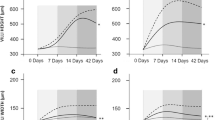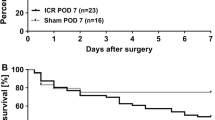Abstract
Net absorption of water, electrolytes, and simple nutrients decreases early after jejunoileal autotransplantation (extrinsic denervation) in a canine model but recovers toward normal by 8 weeks. However, the ability of the extrinsically denervated ileum to adapt after total jejunectomy, which would be relevant as a model of segmental small bowel transplantation, remains unknown. Two groups of five dogs each were studied before and 2 weeks and 12 weeks after 50% proximal enterectomy. A control group remained neurally intact, whereas the other group underwent extrinsic denervation (Ext Den) of the remaining ileum. Using a perfusion technique, net absorption of water, electrolytes, and five simple nutrients (glucose, arginine, glutamine, and oleic and taurocholic acids) was measured at the three time points. Heal morphometry was also evaluated. All dogs developed diarrhea, which resolved by 12 weeks in all but two of the Ext Den dogs. Weight in both groups was decreased at 2 weeks (P <0.05), returned to normal at 12 weeks in control dogs, but remained low in Ext Den dogs (P <0.05). Maximal weight loss was greater in the Ext Den group (P <0.05). No consistent or important differences in net absorptive fluxes of water, electrolytes, or simple nutrients were noted either within or between groups at any time point. Villous height, crypt depth, and longitudinal muscle width increased significantly at 12 weeks after jejunectomy in the Ext Den dogs, but not in the control dogs (P <0.05). Extrinsic denervation of the ileum results in persistent weight loss after proximal 50% enterectomy. Despite diarrhea, only minor changes in electrolyte absorption occur, and ileal net absorption of simple nutrients remains unaffected. The ileum of extrinsically denervated dogs undergoes a more prominent morphometric adaptation after jejunectomy. Extrinsic denervation necessitated by small bowel transplantation, independent of immune effects, does not appear to suppress the ileal adaptive response to maintain net absorption of water, electrolytes, and simple nutrients.
Similar content being viewed by others
References
Williamson RCN, Chir M. Intestinal adaptation. N Engl J Med 1978;298:1393–1404, 1444–1450.
Klimberg VS, Souba WW, Salloum RM, Holley DT, Hauta-maki RD, Dolson DJ, Copeland EM III. Intestinal glutamine metabolism after massive small bowel resection. Am J Surg 1990;159:27–32.
Rahman MS, Taguchi T, Nakao M, Yamada T, Suita S. Longterm results of short segmental syngeneic small intestinal transplantation: Comparison of jejunal and ileal grafts. J Pediatr Surg 1996;31:908–911.
Jenkins AP, Thompson RP. Mechanisms of small intestinal adaptation. Dig Dis 1994;12:15–27.
Alison MR, Sarraf CE. The role of growth factors in gastrointestinal cell proliferation. Cell Biol Int 1994;18:l-10.
Wang HT, Miller JH, Avissar N, Sax HC. Small bowel adaptation is dependent on the site of massive enterectomy. J Surg Res 1999;84:94–100.
Grant D. Intestinal transplantation: 1997 report of the international registry. Intestinal Transplant Registry. Transplantation 1999;67:1061–1064.
Jaffe BM, Beck R, Flint L, Gutnisky G, Haque S, Lambiase L, Tesi RJ. Living-related small bowel transplantation in adults: a report of two patients. Transplant Proc 1997;29:1851–1852.
Jaffe BM, Burgos AA, Martinez-Noack M. The use of jejunal transplants to treat a genetic enzyme deficiency. Ann Surg 1996;223:649–656.
Sarr MG, Duenes JA, Walters AM. Jejunal and ileal absorptive function after a model of canine jejunoileal autotransplantation. J Surg Res 1991;51:223–229.
Sarr MG, Duenes JA, Tanaka M. A model of jejunoileal in vivo neural isolation of the entire jejunoileum: Transplantation and the effect on intestinal motility. J Surg Res 1989;47:266–272.
Yanoff SR, Willard MD, Boothe HW, Walker M. Short bowel syndrome in four dngs. Vet Surg 1992;21:217–222.
Herkes SM, Smith CD, Sarr MG. Jejunal responses to absorptive and secretory stimuli in the neurally isolated jejunum in vivo. Surgery 1994;116:576–586.
Oishi AJ, Sarr MG. Intestinal transplantation: Effects on ileal enteric absorptive physiology. Surgery 1995;117:545–553.
Quiglcy EM, Thompson JS. Effects of artificial ileocolonic sphincter on motility in intestinal remnant following subtotal small intestinal resection in the dog. Dig Dis Sci 1994;39:1222–1228.
Feldman EJ, Dowling RH, McNaugton J, Peters TJ. Effects of oral versus intravenous nutrition on intestinal adaptation after small bowel resection in the dog. Gastroenterology 1976;70:712–719.
Andrews NT, Irving MH. Human gut hormone profiles in patients with short bowel syndrome. Dig Dis Sci 1992;37:729–732.
Sarr MG, Siadati MR, Bailey J, Lucas DL, Roddy DR, Duenes JA. Neural isolation of the jejunoileum. Effect on tissue morphometry, mucosal disaccharidase activity, and tissue peptide content. J Surg Res 1996;61:416–424.
Foley MK, Inoue Y, Souba WW, Sarr MG. Extrinsic innervation modulates canine jejunal transport of glutamine, alanine, leucine, and glucose. Surgery 1998:123:321–329.
Oishi AJ, Inoue Y, Souba WW, Sarr MG. Alterations in carrier-mediated glutamine transport after a model of canine jejunal autotransplantation. Dig Dis Sci 1996;41:1915–1924.
Cosnes J, Gendre JP, Le Quintrec Y. Role of the ileocecal valve and site of intestinal resection in malabsorption after extensive small bowel resection. Digestion 1978;18:329–336.
Thompson JS, Quigley EM, Adrian TE. Factors affecting outcome following proximal and distal intestinal resection in the dog: An examination of the relative roles of mucosal adaptation, motility, luminal factors, and enteric peptides. Dig Dis Sci 1999;44:63–74.
Nygaard K. Resection of the small intestine in rats. 3. Morphological changes in the intestinal tract. Acta Chir Scand 1967;133:233–248.
Booth CC, Evans KT, Menzies T, Street DF. Intestinal hypertrophy following partial resection of the small bowel in the rat. Br J Surg 1959; 46:403–410.
Appleton GVN, Bristol JB, Williamson RCN. Proximal enterectomy provides a stronger systemic stimulus to intestinal adaptation than distal enterectomy. Gut 1987;28:165–168.
Rijke RPC, Hanson WR, Plaiser HM. The effect of transposition to jejunum on epithelial cell kinetics in an ileal segment. Cell Tissue Kinet 1977;10:399–406.
Bristol JB, Williamson RCN. Nutrition, operations and intestinal adaptations. J Parenter Enteral Nutr 1988; 12:299–309.
Chu KU, Tsuchiya T, Ishizuka J, Uchida T, Townsend CM, Thompson JC. Trophic response of gut and pancreas after ileojejunal transposition. Ann Surg 1995;221:249–256.
Tamada H, Nezu R, Matsuo Y, Imamura I, Takagi Y, Okada A. Alanyl glutamine-enriched total parenteral nutrition restores intestinal adaptation after either proximal or distal massive resection in rats. J Parenter Enterai Nutr 1993;17:236–242.
Antonson DL, Vanderhoof JA. Zinc absorption following massive small bowel resection in the rat. Dig Dis Sci 1982;27:789–793.
Lauronen J, Pakarinen MP, Kuusanmaki P, Savilahti E, Vento P, Paavonen T, Ilalttunen J. Intestinal adaptation after massive proximal small bowel resection in the pig. Scand J Gastroenterol 1998;33:152–158.
Lauronen J, Pakarinen MP, Kuusanmaki P, Savilahti E, Vento P, Paavonen T, Halttunen J. Synchronous ideal autotransplantation impairs adaptation of remaining gut in pigs with proximal small bowel resection. Dig Dis Sci 1999;44:2187–2195.
Author information
Authors and Affiliations
Additional information
Supported in part by a grant from the National Institutes of Health (N1H RO1 39337—MGS).
Rights and permissions
About this article
Cite this article
Tsiotos, G.G., Kendrick, M.L., Libsch, K. et al. Ileal absorptive adaptation to jejunal resection and extrinsic denervation: Implications for living-related small bowel transplantation. J Gastrointest Surg 5, 517–524 (2001). https://doi.org/10.1016/S1091-255X(01)80090-1
Issue Date:
DOI: https://doi.org/10.1016/S1091-255X(01)80090-1




